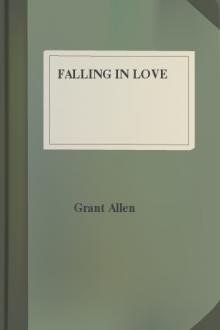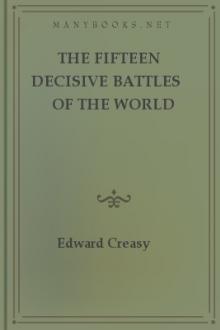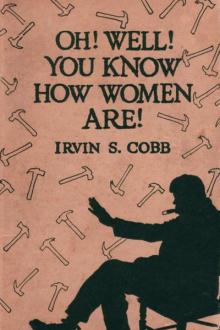Falling in Love by Grant Allen (different e readers .txt) 📕

- Author: Grant Allen
- Performer: -
Book online «Falling in Love by Grant Allen (different e readers .txt) 📕». Author Grant Allen
Second in age is the warm western and south-western type, the type represented by the Portuguese slug, the arbutus trees and Mediterranean heaths of the Killarney district, the flora of Cornwall and the Scilly Isles, and the peculiar wild flowers of South Wales, Devonshire, and the west country generally. This class belongs by origin to the submerged land of Lyonesse, the warm champaign country that once spread westward over the Bay of Biscay, and derived from the Gulf Stream the genial climate still preserved by its last remnants at Tresco and St. Mary's. The animals belonging to this secondary stratum of our British population are few and rare, but of its plants there are not a few, some of them extending over the whole western shores of England, Wales, Scotland, and Ireland, wherever they are washed by the Gulf Stream, and others now confined to particular spots, often with the oddest apparent capriciousness. Thus, two or three southern types of clover are peculiar to the Lizard Point, in Cornwall; a little Spanish and Italian restharrow has got stranded in the Channel Islands and on the Mull of Galloway; the spotted rock-rose of the Mediterranean grows only in Kerry, Galway, and Anglesea; while other plants of the same warm habit are confined to such spots as Torquay, Babbicombe, Dawlish, Cork, Swansea, Axminster, and the Scilly Isles. Of course, all peninsulas and islands are warmer in temperature than inland places, and so these relics of the lost Lyonesse have survived here and there in Cornwall, Carnarvonshire, Kerry, and other very projecting headlands long after they have died out altogether from the main central mass of Britain. South-western Ireland in particular is almost Portuguese in the general aspect of its fauna and flora.
Third and latest of all in time, though almost contemporary with the southern type, is the central European or Germanic element in our population. Sad as it is to confess it, the truth must nevertheless be told, that our beasts and birds, our plants and flowers, are for the most part of purely Teutonic origin. Even as the rude and hard-headed Anglo-Saxon has driven the gentle, poetical, and imaginative Celt ever westward before him into the hills and the sea, so the rude and vigorous Germanic beasts and weeds have driven the gentler and softer southern types into Wales and Cornwall, Galloway and Connemara. It is to the central European population that we owe or owed the red deer, the wild boar, the bear, the wolf, the beaver, the fox, the badger, the otter, and the squirrel. It is to the central European flora that we owe the larger part of the most familiar plants in all eastern and southeastern England. They crossed in bands over the old land belt before Britain was finally insulated, and they have gone on steadily ever since, with true Teutonic persistence, overrunning the land and pushing slowly westward, like all other German bands before or since, to the detriment and discomfort of the previous inhabitants. Let us humbly remember that we are all of us at bottom foreigners alike, but that it is the Teutonic English, the people from the old Low Dutch fatherland by the Elbe, who have finally given to this isle its name of England, and to every one of us, Celt or Teuton, their own Teutonic name of Englishmen. We are at best, as an irate Teuton once remarked, 'nozzing but segond-hand Chermans.' In the words of a distinguished modern philologist of our own blood, 'English is Dutch, spoken with a Welsh accent.'
THUNDERBOLTSThe subject of thunderbolts is a very fascinating one, and all the more so because there are no such things in existence at all as thunderbolts of any sort. Like the snakes of Iceland, their whole history might, from the positive point of view at least, be summed up in the simple statement of their utter nonentity. But does that do away in the least, I should like to know, with their intrinsic interest and importance? Not a bit of it. It only adds to the mystery and charm of the whole subject. Does anyone feel as keenly interested in any real living cobra or anaconda as in the non-existent great sea-serpent? Are ghosts and vampires less attractive objects of popular study than cats and donkeys? Can the present King of Abyssinia, interviewed by our own correspondent, equal the romantic charm of Prester John, or the butcher in the next street rival the personality of Sir Roger Charles Doughty Tichborne, Baronet? No, the real fact is this: if there were thunderbolts, the question of their nature and action would be a wholly dull, scientific, and priggish one; it is their unreality alone that invests them with all the mysterious weirdness of pure fiction. Lightning, now, is a common thing that one reads about wearily in the books on electricity, a mere ordinary matter of positive and negative, density and potential, to be measured in ohms (whatever they may be), and partially imitated with Leyden jars and red sealing-wax apparatus. Why, did not Benjamin Franklin, a fat old gentleman in ill-fitting small clothes, bring it down from the clouds with a simple door-key, somewhere near Philadelphia? and does not Mr. Robert Scott (of the Meteorological Office) calmly predict its probable occurrence within the next twenty-four hours in his daily report, as published regularly in the morning papers? This is lightning, mere vulgar lightning, a simple result of electrical conditions in the upper atmosphere, inconveniently connected with algebraical formulas in x, y, z, with horrid symbols interspersed in Greek letters. But the real thunderbolts of Jove, the weapons that the angry Zeus, or Thor, or Indra hurls down upon the head of the trembling malefactor—how infinitely grander, more fearsome, and more mysterious!
And yet even nowadays, I believe, there are a large number of well-informed people, who have passed the sixth standard, taken prizes at the Oxford Local, and attended the dullest lectures of the Society for University Extension, but who nevertheless in some vague and dim corner of their consciousness retain somehow a lingering faith in the existence of thunderbolts. They have not yet grasped in its entirety the simple truth that lightning is the reality of which thunderbolts are the mythical, or fanciful, or verbal representation. We all of us know now that lightning is a mere flash of electric light and heat; that it has no solid existence or core of any sort; in short, that it is dynamical rather than material, a state or movement rather than a body or thing. To be sure, local newspapers still talk with much show of learning about 'the electric fluid' which did such remarkable damage last week upon the slated steeple of Peddlington Torpida Church; but the well-crammed schoolboy of the present day has long since learned that the electric fluid is an exploded fallacy, and that the lightning which pulled the ten slates off the steeple in question was nothing more in its real nature than a very big immaterial spark. However, the word thunderbolt has survived to us from the days when people still believed that the thing which did the damage during a thunderstorm was really and truly a gigantic white-hot bolt or arrow; and, as there is a natural tendency in human nature to fit an existence to every word, people even now continue to imagine that there must be actually something or other somewhere called a thunderbolt. They don't figure this thing to themselves as being identical with the lightning; on the contrary, they seem to regard it as something infinitely rarer, more terrible, and more mystic; but they firmly hold that thunderbolts do exist in real life, and even sometimes assert that they themselves have positively seen them.
But, if seeing is believing, it is equally true, as all who have looked into the phenomena of spiritualism and 'psychical research' (modern English for ghost-hunting) know too well, that believing is seeing also. The origin of the faith in thunderbolts must be looked for (like the origin of the faith in ghosts and 'psychical phenomena') far back in the history of our race. The noble savage, at that early period when wild in woods he ran, naturally noticed the existence of thunder and lightning, because thunder and lightning are things that forcibly obtrude themselves upon the attention of the observer, however little he may by nature be scientifically inclined. Indeed, the noble savage, sleeping naked on the bare ground, in tropical countries where thunder occurs almost every night on an average, was sure to be pretty often awaked from his peaceful slumbers by the torrents of rain that habitually accompany thunderstorms in the happy realms of everlasting dog-days. Primitive man was thereupon compelled to do a little philosophising on his own account as to the cause and origin of the rumbling and flashing which he saw so constantly around him. Naturally enough, he concluded that the sound must be the voice of somebody; and that the fiery shaft, whose effects he sometimes noted upon trees, animals, and his fellow-man, must be the somebody's arrow. It is immaterial from this point of view whether, as the scientific anthropologists hold, he was led to his conception of these supernatural personages from his prior belief in ghosts and spirits, or whether, as Professor Max Müller will have it, he felt a deep yearning in his primitive savage breast toward the Infinite and the Unknowable (which he would doubtless have spelt, like the Professor, with a capital initial, had he been acquainted with the intricacies of the yet uninvented alphabet); but this much at least is pretty certain, that he looked upon the thunder and the lightning as in some sense the voice and the arrows of an aërial god.
Now, this idea about the arrows is itself very significant of the mental attitude of primitive man, and of the way that mental attitude has coloured all subsequent thinking and superstition upon this very subject. Curiously enough, to the present day the conception of the thunderbolt is essentially one of a bolt—that is to say, an arrow, or at least an arrowhead. All existing thunderbolts (and there are plenty of them lying about casually in country houses and local museums) are more or less arrow-like in shape and appearance; some of them, indeed, as we shall see by-and-by, are the actual stone arrowheads of primitive man himself in person. Of course the noble savage was himself in the constant habit of shooting at animals and enemies with a bow and arrow. When, then, he tried to figure to himself the angry god, seated in the storm-clouds, who





Comments (0)